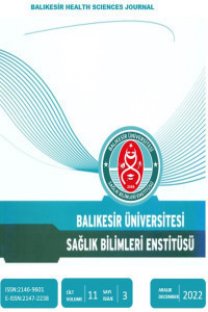Erken Gebelikte Diyabet, Sıçanların Endometrial Bezlerinin Karbonhidrat Salgılarını Etkiler mi?
Does Diabetes Affect the Carbohydrate Secretions of the Endometrial Glands of Rats in Early Pregnancy?
___
- Akif F., Gabius H. J., & Danguy A. (1995). Estrus cyclerelated alterations in the expression of glycoconjugates and lectins in the Mouse endometrium shown histochemically. Tissue & Cell, 27(2), 197-206.
- Burton G. J., Jauniaux E., & Charnock-Jones D. S. (2007). Human early placental development: potential roles of the endometrial glands. Placenta 28(Suppl. A, Troph Res (21), 64-69.
- Bychkov V., & Toto P. D. (1987). Histochemical study of lectin binding to gestational epithelium. Int J Gynecol Pathol, 6, 66-72.
- Bychkov V., & Toto P. D. (1986). Lectin binding to normal human endometrium. Gynecol Obstet Invest, 22, 29-33.
- Cornejo-Garrido J., Becerril-Chávez F., Carlín-Vargas G., Ordoñez-Rodríguez J. M., Abrajan-González Mdel C., de la Cruz-Ramírez R., & OrdazPichardo C. (2014). Antihyperglycaemic effect of laser acupuncture treatment at BL20 in diabetic rats, Acupunct Med, 32(6), 486-494.
- Dey S. K., Lim H., Das Sanjoy K., Reese J., Paria B. C., Daikoku T., & Wang H., (2004). Molecular cues to implantation, Endocrine Reviews, 25(3), 341– 373.
- Gutaj P., Zawiejska A., Wender-Ożegowska E., & Brązert J. (2013). Maternal factors predictive of first trimester pregnancy loss in women with pregestational diabetes. Pol Arch Med Wewn. 123(1-2), 21-28.
- Hempstock J., Cindrova-Davies T., & Jauniaux E.(2004). Endometrial glands as a source of nutrients, growth factors and cytokines during the first trimester of human pregnancy: a morphological and immunohistochemical study. Reprod Biol Endocrinol, 2, 58-63.
- Isola M., Cossu M., & Diana M. (2012). Diabetes reduces statherin in human parotid: Immunogold study and comparison with submandibular gland. Oral Diseases,18(4), 360-364.
- Jones C. J. P., Aplin J. D., Burton G. J. (2010) First Trimester Histiotrophe Shows Altered Sialylation compared with secretory phase glycoconjugates in human endometrium, Placenta, 315(76e), 580.
- Jones C. J. P., Fazleabas A. T., & Mcginlay P. B. (1998) Cyclic modulation of epithelial glycosylation in human and baboon (Papio anubis) endometrium demonstrated by the binding of the agglutinin from Dolichos biflorus (DBA). Biol Reprod; 58, 20-27.
- Kupryjancyzk J. (1989). Cycle and function related changes in lectin binding to human endometrium: a histochemical study with pronase treatment. Arch Gynecol Obstet, 246, 211-222.
- Lee M.C., & Damjanov I. (1985). Pregnancy-related changes in the human endometrium revealed by lectin histochemistry. Histochemistry, 82, 275- 280.
- Leitner M., Aurich J. E., & Galabova G. (2003). Lectin binding patterns in normal canine endometrium and in bitches with pyometra and cystic endometrial hyperplasia. Histol. Histopathol, 18, 787-795.
- Lilliu M. A., Solinas P., & Cossu M. (2015). Diabetes causes morphological changes in human submandibular gland: a morphometric study. J Oral Patho. Med., 44(4), 291-295.
- Lohmiller J. L., & Swing S. P. (2006). Reproduction and breeding in the laboratory rat, p.148-153 Academic Press, London (2006).
- Lutsky A. & Sogomonian E. (2012). Structural, functional, and lectin histochemical characteristics of rat ovaries and endometrium in experimental hyper and hypothyroidism. Folia Histochemica et Cytobiologica, 10, 375-382.
- Monsefi M., Hosseini E., & Alaee S. (2013). Lectin histochemical study of rat reproductive tissues treated with ether fraction of Anethum graveolens L. Extracts. Anatomical Sciences, 10, 41-49.
- Munson L., Kao J. J., & Schlafer D. H. (1989). Characterization of glycoconjugates in the bovine endometrium and chorion by lectin histochemistry. J. Reprod. Fert, 87, 509-517.
- Öztabak K. Ö. (2005). Lektinler ve viscum album agglutinin, Erciyes Üniv. Vet. Fak. Derg.; 2(1), 55-59.
- Peel S. & Bulmer J. N. (1996). Lectin histochemistry of pregnant rat uterine tissues, J.Anat, 188, 197-205.
- Stevens M. J., Li F., Drel V. R., Abatan O. I., Kim H., Burnett D., Larkin D., & Obrosova I. G. (2007). Nicotinamide reverses neurological and neurovascular deficits in streptozotocin diabetic rats. Journal of Pharmacology and Experimental Therapeutics; 320(1), 458-464.
- Stewart J., Bebington C. R., & Mukhtar D. D. Y. (2000). Lectin binding characteristics of mouse placental cells. J. Anat., 196, 371-378.
- Walter I. & Bavdek S. (1997). Lectin binding patterns of porcine oviduct mucosa and endometrium during the oestrus cycle. J.Anat, 190, 299-307.
- ISSN: 2146-9601
- Yayın Aralığı: Yılda 3 Sayı
- Yayıncı: BALIKESİR ÜNİVERSİTESİ
Çocuklarda Tırnak Yeme Davranışı: Onikofaji
Cerrahi Kliniklerde Yatan Hastaların Psikolojik Yardım Arama Tutumu
Melike ERTEM, Sevdagül KARAGÖZ
Erken Gebelikte Diyabet, Sıçanların Endometrial Bezlerinin Karbonhidrat Salgılarını Etkiler mi?
Edibe PİRİNÇCİ, Enis ÖZKAN, İbrahim Halil AKKUŞ, Osman KURT, Ufuk ACAR, A. Ferdane OĞUZÖNCÜL, Süleyman Erhan DEVECİ
Şafak DAĞHAN, Gülçin UYANIK, Rukiye AKIN, Melek SÖZERİ
Sağlıklı Yaşam Biçimi Davranışları Kapsamında Özel Gereksinimi Bulunan Çocukların Ebeveynleri
Gülay MANAV, Sema KAYA, Gonca KARAYAĞIZ MUSLU
Yenidoğanlarda Ağrı Yönetiminde Kullanılan Kanıt Temelli Nonfarmakolojik Hemşirelik Uygulamaları
Duygu KEMER, Ayşegül İŞLER DALGIÇ
Balıkesir İl Merkezindeki Gebe Kadınların Prenatal Bakım Alma Durumu ve Etkileyen Faktörler
